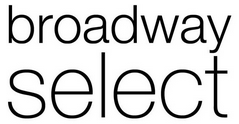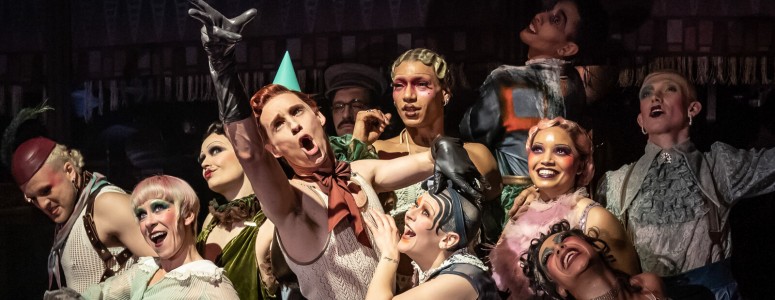It’s become a favorite go-to concept for journalists.
“Five Takeaways from (whatever).”
“Five Takeaways from the Trump trial.” “Five Takeaways from the latest White Sox loss.” “Five Takeaways from Taylor Swift’s Concert.”
And here are five notable takeaways from the 2024 production of CABARET.
To be more accurate, CABARET AT THE KIT KAT CLUB is now its name, thanks to its immersive nightclub staging.
Rebecca Frecknall’s production is very controversial, with many nay-sayers having their nays. Many wished that they could simply return to the vision that Harold Prince had for the original 1966 production. What was wrong with a show that had won eight Tonys, including Best Musical?
Nearly a year before that victory happened, in the summer of 1966, I read WELCOME TO BERLIN before the title was changed to CABARET. I saw the Boston tryout twice, the first Broadway revival twice, the second once four times and the third one but two.
Needless to say, I’ve also seen the 1972 Bob Fosse film, which he – in collaboration with screenwriter Jay Presson Allen – reimagined the musical.
Smartest of all was to take a diegetic approach – meaning that people who sing are quite aware they’re singing. So Sally and The Emcee did all but one number in the Kit Kat Club. The only exception was the anthem sung outdoors by a Hitler Youth who was soon joined by others that were embracing the Nazi cause.
There’s a good chance that subsequent new theater artists are inspired to put a radical spin on CABARET because the film played so fast and loose with so much of Joe Masteroff’s original libretto. It seems to have given them permission to try something new.
And at least five of Frecknall’s innovations rank with the best of any seen in previous CABARETS.
1—Just before the lights dim, klezmer music is playing. The sound associated with Jews serves as a reminder that before the Nazis took power, such music was routinely heard in Berlin’s nightclubs.
That would change.
2—“If You Could See Her” has always been controversial. When the show opened at the Shubert in Boston on October 8, 1966, The Emcee surprised and shocked many first-nighters by saying that if we could view the gorilla on his arm the way he does, “She wouldn’t look Jewish at all.”
As time went on, the complaints grew, so the lyric was changed to “She isn’t a meeskite at all.” It’s a Jewish term used for a not-so-good-looking individual. The word was introduced late in the first act when Herr Schultz sang “Meeskite” to entertain the guests at his engagement party.
If you need any convincing that the change was made reluctantly, just take a look at the published hardcover edition of CABARET. It includes both lyrics, with the Jewish one listed as “Alternate.”
When the film was released in 1972, much was made of Fosse and Allen’s courage in reverting to “She wouldn’t look Jewish at all.” There was more to it than that; both Herr Schultz (and his beloved Fraulein Schneider) as well the song were dropped, so “meeskite” wouldn’t have meant anything and couldn’t be included.
What’s been in place in every iteration was a gorilla that was made to look adorable via a funny hat and big smile. Not here, for Frecknall has instead opted for an oversized, menacing and primitive beast that lumbers onto the stage. It’s a smart way of expressing the view that the Nazis wanted to put in people’s heads: Jews were dangerous and sub-human.
3—The title song, despite John Kander’s happy-go-lucky music, has always carried an underbelly because of Fred Ebb’s caustic lyrics. Here, though, Frecknall and the Sally Bowles of Gayle Rankin have gone into the most over-the-top rendition of the song yet seen on Broadway.
This time, “over-the-top” is an observation, not a criticism. It makes sense that Sally would be out of control, for lately she’s been going through a lot and has plenty on her mind. Did she want to have a child? Did she instead want an abortion? If so, how could she possibly pay for it? Will a doctor take her fur coat in exchange for his services?
That’s not all. Is Cliff right about the Nazis? Must they move? She’s starting to think he has a point.
All this is enough to give anyone a nervous breakdown. That’s what Sally seems to be having, more and more as the song continues.
If a cast album is released, you may find that Rankin’s rendition is not your favorite of all time. On stage, however, it packs quite a wallop.
4—When the show starts, Eddie Redmayne, who’s now inherited the role of The Emcee, is dressed flamboyantly and effeminately (close to Alan Cumming’s look in the 1998 revival). By the end of the show, he’s in a formal dress suit.
That makes sense, too, because the Nazis were dead set against what they considered degeneracy – and that included anything that even suggested homosexuality. This Emcee has decided to conform and put aside his free-and-easy inclinations. Otherwise, he might lose his job. Who knows? The way things are going in this this society, he might even lose his life.
5—The production is in the round on a stage that sports a turntable. At one point in the first act, figurines that are approximately 18 inches high are dotted around it. Ever so slowly, they pass by, as if they were human figures on a carousel.
This leads to a coup de théâtre at the end of the show. It won’t be divulged here, not even with the preamble “Spoiler alert.” No; put down your diary, remote and dessert; come to the CABARET AT THE KIT KAT CLUB and see these five takeaways.
And don’t be surprised if you find plenty of other impressive ones in Rebecca Frecknall’s dynamic vision.




